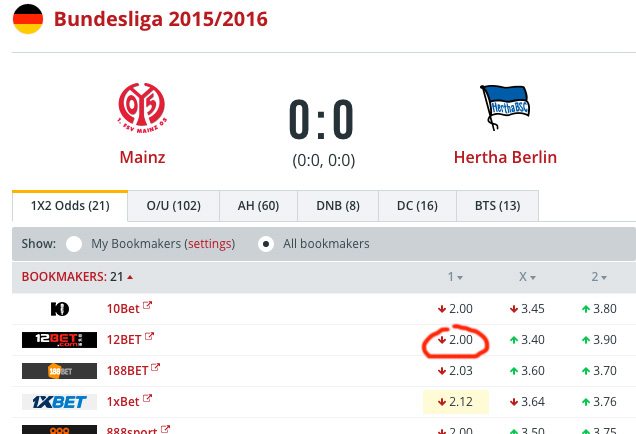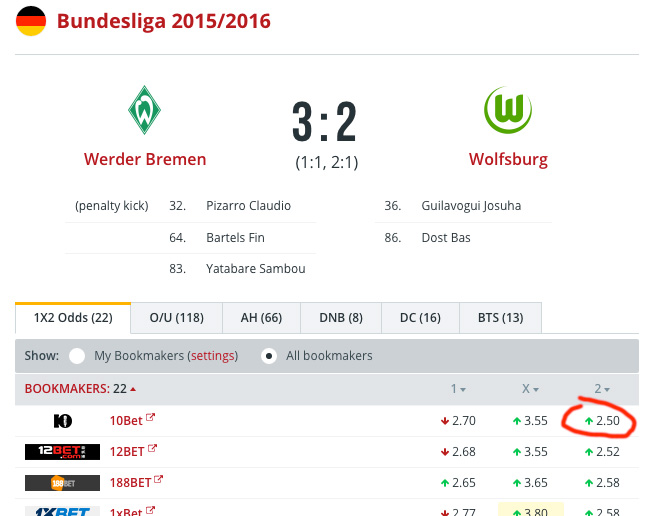Contents
In this article, we will have a thorough look at the rules of the Dutch system, learn how to properly bet with the strategy and highlight its advantages and disadvantages.
The Basics of the Strategy
So, what is the idea of the Dutch strategy? In fact, it is an upgraded version of the well-known Martingale system. Only with the Martingale strategy, you increase the amount of each next bet, while with the Dutch system, the proportional increase applies not only to the bet amount but also to the odds — until the full cycle is over.
To earn with the strategy, you need to:
- Increase each next bet by the amount of your first bet.
- After every lost bet, the odds for the next bet must be increased by 0.5.
- The amount of your first bet must not exceed 1/20 of your bank. Otherwise, you risk to not complete the cycle and, consequently, lose all your money.
The Rules of the Dutch Betting System on an Example:
- Let’s assume your first bet is 100 dollars and the odds are 1.5.
- If the bet wins, your net profit will be 50 dollars and your bank will be: 2,000+50=2,050 dollars.
- If not, the odds for your next bet must be 2.0 and the bet amount — 200 dollars. If you are unlucky again, the odds for the third bet must be 2.5 and the bet amount — 300 dollars. You are supposed to continue like this until you win. When the cycle is over, start again with the minimum stake of 100 dollars and the odds of 1.5.
| Bet # | Bet Amount | Odds | Outcome | Balance |
|---|---|---|---|---|
| Bet 1 | 100 | 1.5 | Loss | 2000-100 = 1900 |
| Bet 2 | 200 | 2.0 | Loss | 1900-200 = 1700 |
| Bet 3 | 300 | 2.5 | Loss | 1700-300 = 1400 |
| Bet 4 | 400 | 3.0 | Win | 1400+800 = 2200 |
As is shown in the table, on completing the cycle, our profit amounted to 200 dollars, and it only took us four bets to win.
The Dutch Betting System in Practice: Test
In this paragraph, I will show you a practical example of the Dutch system.
For our first bet, we will pick the bet on the win of Bavaria.
Bet 1: 100 dollars, odds 1.5.

Bavaria failed to defeat their opponents and we lost the bet.
Bet 2: 200 dollars, odds 2.0.

Mainz could not win over Gerta and we lost again.
Strictly following the strategy rules, we make the third bet of 300 dollars.
Bet 3: 300 dollars, odds 2.5.

Wolfsburg could not win, and we are supposed to further increase the bet amount and the odds.
Resume: 2,000-100-200-300 = $1,400
So, by the fourth bet, we have already lost a quarter of the bank and now we are to bet on an event with odds of 3. Does it make sense to continue? I don’t think so.
Can You Win Using the Dutch System?
If you get lucky and the cycle is soon over, you are sure to win. But if, after the sixth bet, luck is still not on your side, your chances to win tend to zero.
Just think about it — you will have to make your seventh bet with odds of 4.5 and the tenth — with 6.0. How often do such odds win?
Let us look at the finances. If you face a 14-event losing streak, then, even in our example with a 100-dollar first bet, by the 15th bet, you’ll have to bet 6,000 dollars. As for odds, they’ll have to be 9.5. I guess there is no need to explain that the probability of such odds to win in real life is extremely remote.
Besides, a big disadvantage of the strategy is the fact that you do not ‘work’ with a particular team that will, sooner or later, play as you expect it to. Instead, you become a hostage to the Dutch strategy and choose odds for the next bet based on intuition. As a matter of fact, there is little consistency here. In the long run, the strategy will disappoint you and leave you deep in the red.
Considering all said above, I can’t recommend the strategy to you. I think it is absolutely absurd and inviable. Despite the golden rule ‘the higher the odds, the lower the bet’, the Dutch system implies increasing the bet amount and decreasing the probability to win, which, in the end, will lead to losing your bankroll. Obviously, that wasn’t part of your plan.




